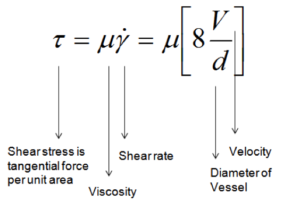Simple fluids such as water as well as blood plasma and serum are Newtonian fluids, which means their viscosity is constant regardless of shear rate. Whole blood behaves as a non-Newtonian fluid, and its viscosity changes dramatically as a function of shear rate. Shear rate is proportional to blood flow velocity divided by the lumen diameter. Endothelial shear stress, which is frictional force applied by pulsatile blood flow against the vessel wall, is defined as blood viscosity multiplied by the shear rate.

When blood moves quickly as in peak-systole, it is physically thinner. When it moves slowly during end-diastole it is thicker and stickier. Blood is subjected to a wide range of shear rates during each cardiac cycle—from peak-systole (high shear) to end-diastole (low shear).
Other laboratories that provide blood viscosity analysis are capable of performing high-shear viscosity measurements. Only Rheovector provides a Whole Blood Viscosity Test that incorporates both high and low-shear measurements. Low-shear viscosity represents flow resistance in the microvasculature, where blood moves very slowly at a velocity of approximately 0.01 cm/s or less. At this slow flow, blood viscosity is 2-5 times higher than at high-shear even in healthy adults. In numerous disease states and conditions, cellular interactions between red cells, platelets, leukocytes and plasma proteins create the milieu for thrombosis. At low shear rates, blood viscosity is an established integrating measure of these prothrombotic interactions.
The Whole Blood Viscosity Test is a dynamic measure of blood flow that accounts for cellular interactions at low shear rates and erythrocyte deformability at high shear rates.
Comments are closed.